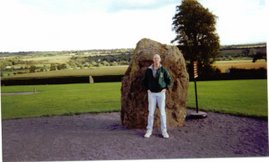Tuesday, March 07, 2006
Sky and Telescope Tuesday. Baseball Hall of Famer Kirby Puckett dead at 45.
Jupiter's New Little Red Spot
Today I bring you two hot articles I spied on the Sky and Telescope web site. The first article describes a new feature on the disk of Jupiter, the largest planet in our Solar System. Apparently, a new red spot, slightly smaller than the famous Great Red Spot, has been detected in the Jovian atmosphere. Excerpt:
March 6, 2006 There's a strange event brewing on Jupiter. The long-enduring, much-observed "white oval" on Jupiter designated BA has been reddening, and now its color is almost identical to the famous Great Red Spot. The oval lies in the South Temperate Belt. It preceeds the Great Red Spot by about 1 hour of Jupiter's rotation.
The new red spot, affectionately dubbed "Red Junior" or "Red Spot Junior" by some astronomers, is nearly half the size of the Great Red Spot, which means it has about the same diameter as Earth. It can be seen in telescopes with apertures 10 inches or larger.
The color change was discovered on February 24, 2006, by Philippine-based planetary imager Christopher Go, who sent out an alert through the Jupiter Section of the Association of Lunar and Planetary Observers.
By watching the formation of this new red storm, astronomers may gain precious insight into the Great Red Spot. Despite the fact that astronomers have observed the Spot since the 1600s, they know little about it other than its size (twice the diameter of Earth), wind speed (maximum 435 kilometers per hour, or 270 mph), and altitude (it pokes about 8 km above Jupiter's cloud tops). The storm was discovered as soon as telescopes were good enough to resolve it, so nobody knows how long it has been raging. Its energy source remains unknown. In fact, astronomers have not even conclusively identified the chemicals responsible for its red color, though they probably involve trace amounts of sulfur, phosphorus, and hydrocarbons.
I haven't quite got the equipment the article claims to be a requirement to see this phenomenon, but I'll give it a whirl anyway. My Meade 125-ETX (a 5-inch Matsukov-Cassegrain) can grasp up to 350 power, which is practically useless due to the proportional decrease in light transmission and apparent field size. About half that, 175 power, is best under good seeing conditions. Maybe I'll get lucky.
Near Earth Asteroid Approaches
The second article is a story about a near-Earth asteroid that will pass us by less than ten times the Earth-Moon distance over the next few nights. Excerpt:
On March 6th and 7th, 2006, the near-Earth asteroid 2000 PN9 (also known as asteroid number 23187) will be flying by Earth, missing us by 2 million miles in the northern sky. The asteroid will be 12th magnitude those evenings as it races across the sky; users of 4- or 6-inch and larger telescopes should be able to see it creeping against the background stars — if they know exactly where to look. On March 8th it will be faded to magnitude 12½; on March 9th and 10th it will be magnitude 13.
Again, this baby will be tough for my Meade to bag, as its magnitude is at the theoretical limit for an instrument of that size. Still, I'll give it a go, and maybe again, I'll get lucky.
Little Red Spot Story
Near Earth Asteroid Story
Hall of Famer Kirby Puckett dead at 45
By now, most of you already know that Baseball Hall of Fame outfielder Kirby Puckett, who led his Minnesota Twins to two World Series titles in 1987 and 1991, died after having suffered a stroke.
Puckett, with his stout build, came to the majors as a singles hitter who could fly. He ran down almost everything in center field, and after a few years began to hit home runs. As he developed power, he became a star, and a lovable one at that. He had a wide smile and displayed an obvious joy when he played the game.
Among Kirby's accomplishments was his 1989 American League batting title (.339). He also led the AL in hits four times (and had five seasons with 200 or more), in total bases twice, and RBI once. On defense, he led AL outfielders in putouts three times, and in assists once.
I remember Kirby Puckett as a hustling player who you never wanted to see bat against your team with the game on the line because he was almost impossible to pitch to. At 5' 8" he had a small strike zone, but swung at everything, producing hard line drives into the gaps, almost at will. Puckett was elected to Baseball's Hall of Fame in 2001.
Kirby Puckett's career stats
Subscribe to:
Post Comments (Atom)

No comments:
Post a Comment